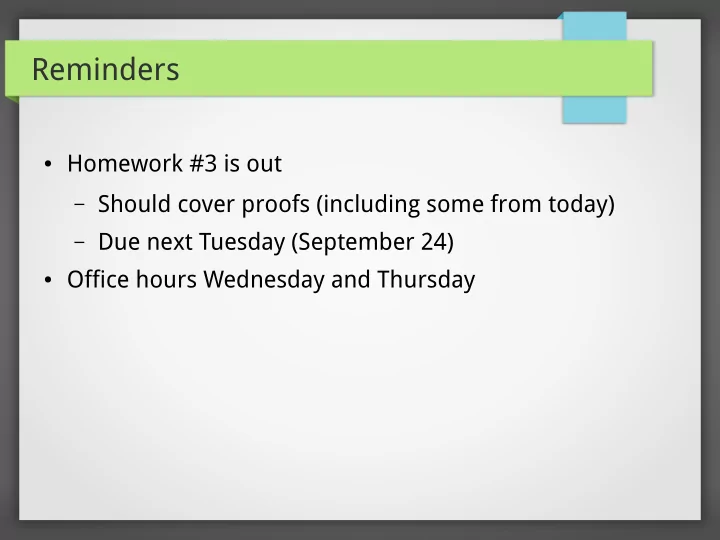

Reminders ● Homework #3 is out – Should cover proofs (including some from today) – Due next Tuesday (September 24) ● Office hours Wednesday and Thursday
Is this Proof Correct?
Is this Proof Correct?
Is this Proof Correct?
CMSC 203: Lecture 6 Proof Methods and Stragies
Existence Proof ● Useful if theorem is of form xP(x) ∃ ● Constructive: Prove an element a exists as a witness – You are producing a solution – Example from book : “There exists a positive integer that can be written as the sum of cubes of positive integers in two different ways.” – 1729 = 10 3 + 9 3 = 12 3 + 1 3
Existence Proof ● Nonconstructive : Do not produce a witness – You are proving using another proof methd – Must show that some solution must exist – Proof by contradiction, for example – Example from book : “Show that there exist irrational numbers x and y such that x ^y is rational”
Uniqueness Proof ● Useful if theorem asserts unique element with property – Exactly one element in a set with property ● Two steps – Existence : Show an element x exists with property – Uniqueness : Show that if y ≠ x , y does not have property (and if y does have property, y = x ) ● Example from book : If a and b are real numbers and a ≠ 0, then there is a unique real number r such that ar + b = 0
Summary of Proofs ● Direct Proof – Assume P(x) and and show Q(x) using rules of inference (such as basic mathematical axioms) ● Contrapositive – Assume Q(x) is false, and use rules of inference to show P(x) is also false ● Contradiction – Assume P(x) is false [or Q(x) in conditionals], and use rules of inference to show any contradiction ● Exhaustive Proof – Show every solution possible ● Proof by Cases – Break into multiple, provable “cases” ● Existence and Uniqueness are special problems
Proof Strategies 1. Write down your hypotheses [ p and q ] 2. Write down all premises (assumed truths) 3. Use existing proof methods, and adapt 4. If conditional ( p → q ), attempt to follow rules of inference from p to reach q ( direct proof ) Fall-back on indirect proofs (like proof by contradiction) Know what proof you are trying to use! 5. Attempt to find a counterexample, and try to prove it (This may not solve the problem, but will be helpful)
Some Tips ● Write down every True statement, and every statement you are assuming True (like in proof by contradiction) ● Know your start point (hypothesis) and end point (hypothesis, or contradiction) ● Only follow known axioms, definitions, or rules of inference ● Never start with q and try to prove p (this is begging the question ) ● Never assume ¬ p and try to show ¬ q , even with a proof by contradiction (this is denying the antecedent )
Practice ● Prove the sum of two odd integers is even. ● Prove every odd integer is the difference of two squares. ● Prove if n is an integer and n 3 +5 is odd, then n is even. ● Prove max( x , y ) + min( x , y ) = x + y ● Prove or disprove there is a rational number x and an irrational number y such that x^y is irrational ● Prove given real number x there exist unique numbers n and e such that x = n - e , n is an integer, and 0 <= e < 1
Recommend
More recommend